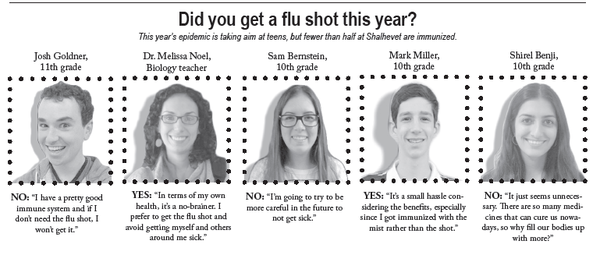Officials try to fight flu among teens, but Shalhevet students not convinced

March 9, 2014
Flu season has hit young people particularly hard this year, prompting concern among public health officials nationwide — but not necessarily among Shalhevet students, who don’t seem particularly worried.
In an informal survey taken Feb. 10, 11 out of 25 students – 44 percent — said they had received a vaccine against influenza this year.
Though influenza usually hits hardest among the elderly and people with weakened immune systems, this year in California alone at least 243 people younger than 65 had died from the flu as of Feb. 14. At the same point last year, that number was 26, according to latimes.com.
“We have seen healthy young adults and children become severely ill with influenza and many have died,” said Dr. Deborah Lehman, Clinical Director of Pediatric Infectious Diseases at Cedars-Sinai Medical Center, in an interview.
“Influenza is responsible for over 300,000 deaths per year,” Dr. Lehman said, “and this year in particular the people who are most affected are the young and healthy, often without underlying conditions.”
Along with teenagers, obese adults are the most vulnerable to contracting swine flu — the dominating strain this year — and both groups are highly encouraged to become vaccinated. The Federal Centers for Disease Control reports that American manufacturers produced 145 million doses of flu vaccine this season, targeted against influenzas H1N1 and H3N2, both Type A, and influenza B virus.
Despite the surplus supply however, not everyone goes to get the shots, even in the most threatened groups.
“I just feel that flu shots are unnecessary if the threat isn’t significant,” said junior Josh Goldner. “I have a pretty good immune system and if I don’t need the flu shot, I won’t get it.”
Sophomore Shirel Benji said she’d rather wait to see if she’d get sick, and then take medicine if needed.
“It just seems unnecessary,” Shirel said. “There are so many medicines that can cure us nowadays, so why fill our bodies up with more?”
Biology teacher Dr. Melissa Noel said studies have shown vaccines to be safe, and that anti-viral treatments only reduce the time you’re ill by one or two days.
“There is a misconception within the general population that vaccines are dangerous and unsafe, with some people even claiming that there is a link between autism and vaccines,” said Dr. Noel. “There is no scientific evidence to support those claims. The flu vaccines have been shown to be safe over and over again.
“In terms of my own health, it’s a no-brainer,” she added. “I prefer to get the flu shot and avoid getting myself and others around me sick. ”
Dr. Lehman said more people are being vaccinated than last year but still too many are not.
“Vaccination rates have steadily risen over the past several years, particularly in medical centers and hospitals where vaccine is strongly encouraged and even required,” Dr. Lehman said. “Vaccinated rates among the public do remain sub optimal — particularly among children.”
For example, Cedars-Sinai employees and volunteers, as wells as their families, are all encouraged to become immunized since they are especially likely to come into contact with the illness. Dr. Lehman said 90 percent of the staff there are vaccinated as a result.
At Shalhevet, the figure is just 44 percent. Junior Rina Katzovitz, who missed a week of first semester because of an illness, got the vaccine and said others should likewise avoid the risk.
“Dying due to contracting the flu can be so easily avoided, yet so many still die each year because they weren’t vaccinated,” Rina said.
Some families who normally would not become immunized decided to receive the flu shot this year. Mr. Jonathan Miller, father of sophomore Mark Miller, took his children to get immunized, and received the flu shot himself for the first time in several years.
“I received the flu shot this year because it is a particularly virulent strain of the flu,” Mr. Miller said.
Many students have experienced flu-like symptoms this winter. Sophomore Samantha Bernstien, who was not innoculated, suffered from a severe head cold and fever for four days.
“I did not get a flu shot,” said Sam, who nevertheless said she would not get a flu shot next year either. “I’m going to try to be more careful in the future to not get sick.”
Freshman Sarit Ashkenazi received a flu shot but got sick anyway, missing five days of school after being diagnosed with influenza. This is because the shot does not guarantee full immunity.
According to pediatrics.about.com, the vaccine effectiveness for children between the ages of six months is 67 percent — about two-thirds. That means if you got a flu shot, your chance of catching the flu is not zero, but it is about one-third the chance compared to if you didn’t.
Dr. Lehman admitted that the vaccine is not a full guarantee, but said it’s far better than other solutions.
“We are fortunate to have vaccine technology to prevent influenza — it’s not perfect but it is the best we have right now,” Dr. Lehman said.
Dr. Noel agreed, and noted that the more people who are vaccinated, the fewer people will get sick – whether they’ve been vaccinated or not.
“Since the flu can be passed on from person to person, vaccination greatly reduces the chances of infection and transmission within a population,” Dr. Noel explained. “That means that if more people are getting vaccinated, then there is less influenza being spread through that community.
“The opposite is also true,” she added. “If fewer people vaccinate, then the chances of infection within a community rises.”
Flu is said to be most prominent during the months of December through March, and peaks during late January to mid- February. Although epidemics of flu occur every year, the severity of the season fluctuates since flu viruses constantly change and new diseases may emerge.
The flu is a respiratory illness caused by the influenza virus. Once the virus enters the body, it attacks the immune system by copying its information onto a host cell. It repeats this process several times, thus multiplying the amount of viruses present, until the host cell cannot contain those viruses anymore. So then, the cell bursts open, which releases thousands of viruses looking for other cells to infect.
Eventually, the body begins to realize that it is being attacked, so the immune system creates antibodies. Once they come into contact with the virus, the antibodies turn into goo and surround the virus, thus preventing it from spreading.
Scientists categorize the flu into three types: Type A, which is the most severe and common, and Types B and C, which are milder forms.
The dominating illness this year has been the type A H1N1 virus, more commonly referred to as swine flu. Swine flu has already taken the lives of over 280,000 people world-wide since its appearance in 2009, according to medicalnewstoday.com It has been a part of every flu season since then, but only this year has it been the dominating strain – which is why this flu season has been so dangerous.
According to its website, the Los Angeles County Department of Health advises people to constantly wash their hands and prevent the flu’s spreading by staying at home rather than going to school if sick and highly encourages all older than six months to be immunized.
The website said that the influenza activity here may have started to abate.
“Influenza activity in Los Angeles County remains at a high level,” the website states. “However, over the past few weeks various indicators show activity may be plateauing.”
Dr. Lehman agreed, saying that the peak is most likely past us, but adding that it is not too late to get the shot.
“Of course the earlier in the season the better,” She said. “But influenza is still circulating so it’s not too late.”













